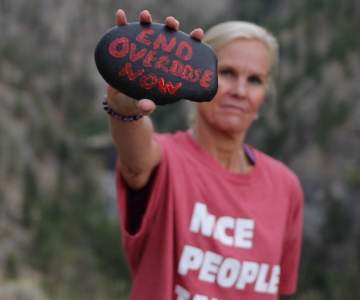Breadcrumb
Explore Stories
5 Minute Read
Community & Culture
One year ago on April 29, Maureen Thomson was sitting at a desk inside the new David E. Kampe Tower at Penticton Regional Hospital (PRH), looking over a set of computer screens, each one flashing patient names and locations.
At the time, Maureen was the health services director and responsible for moving some 65 patients from their hospital rooms to new single-patient accommodations inside the David E. Kampe Tower. The tower, a six-storey addition to PRH that also included a parkade, was ready to open its doors to the public.
Construction had begun in 2016, while planning had taken place for many years prior. It was the culmination of a four-month period known as 'operational commissioning', the period after construction completed and Interior Health had moved in equipment, trained staff, and ultimately moved patients from the older building into the new tower. Years of hard work were coming together in one emotional day.
One year later
Fast forward a year.
The new building is all that was expected, and maybe more. Since the earliest days of planning, it was felt the state-of-the-art tower could change the way health care was delivered at PRH, impacting patients not only in Penticton but right across the region.
According to Carl Meadows, a senior leader in acute and community care in the South Okanagan, it has done just that. “The tower has had a huge impact on patient care for residents of the South Okanagan and Similkameen. There is so much more space right from the main entrance to the clinics and into the single-patient rooms. We are thrilled to have this building as a jewel of health care. It really allows our staff and physicians to thrive and provide exemplary care for patients. It’s a great healing environment for patients, something David Kampe himself was extremely proud of.”
In fact, Mr. Kampe, the philanthropist who donated millions of dollars towards the tower which bears his name, often told Carl that he wanted the hospital to be like a five-star hotel.
The opening ceremony of the new tower included David Kampe and other key members of the PRH project including Dr. Brad Raison, Maureen Thompson and Carl Meadows
When he passed away shortly after the tower opened, the hospital received his Order of B.C. which honoured Mr. Kampe for a lifetime of charitable work. The Order now hangs in the hospital, alongside a stunning array of artwork and sculptures.
And it’s not only the art that adorns seemingly every hallway that makes it unique: Aboriginal signage outside the hospital's main entrance, at patient registration, and elsewhere, welcomes visitors and patients in the traditional Syilx language of the Penticton Indian Band, honouring the knowledge keepers of the land.
“We are just so proud of this facility,” says Carl. “So many people played a key role. It was an immense amount of work and a credit to our staff and physicians that we kept PRH operating the whole time and kept putting patient care first. This is a building that matches the skill and compassion of our staff and physicians.”
Dr. Brad Raison was the Chief of Staff at PRH during the planning, construction and opening of the David E. Kampe Tower. He says the tower has brought positive change but stressed there is more work to be done. “We have seen many positive changes at PRH such as nuclear medicine, a permanent MRI, and single patient rooms," says Brad. "This is merely the beginning. Medicine is constantly changing and with it the need for more and new tools to support these changes. We must continue to build on what we have started. Today’s dreams can be tomorrow’s reality.”
Through the eyes of a patient
When Graham Tungate entered the doors of the David E. Kampe Tower earlier this year to prepare for surgery, the 77-years-young Penticton native was feeling some of the anxiety that goes with any impending procedure. However, the atmosphere in the Kampe Tower put him at ease. “In spite of the continual activity, what is noticeable is the quiet,” says Graham. “The design has allowed an ambiance of peace, quiet and comfort to develop.”
The new coffee shop and the heritage photographs on display also helped to take his mind of the impending procedure.
Beyond the calm and welcoming atmosphere, something else stood out for Graham. “I have to mention something very important that directly affected me as a patient: The culture of the medical staff. It is a team culture and like all good, successful teams, it generates its own energy, which is greater than the sum total of the parts,” says Graham. “The medical staff have high standards, they have pride in their work, but more important than that, they care. They have kindness and compassion. Each time that I leave the tower I feel proud that, as Canadians, in our quiet, modest way, we got it right.”
In the end
The opening of the David E. Kampe Tower marked a new beginning for Penticton Regional Hospital. The discussion began long ago among local decision makers to push for a new hospital in Penticton. Years of planning, detailed design work and collaboration occurred between PRH staff and physicians; Interior Health Capital Planning; the Ministry of Health; funding partners like the SOS Medical Foundation and the Okanagan Similkameen Regional Hospital District; stakeholders including the Penticton Indian Band; and contractor EllisDon Infrastructure.
Construction work is expected to conclude in 2022 with a modernized and much larger Emergency Department among the changes.
For Maureen Thomson, who has since retired, it was all about the team. She says everyone involved deserves part of the credit. “This was one of the most remarkable team-based initiatives that you could possibly have,” she says. “Our staff and physicians put their heart and souls into the work and it’s completely evident in the results of the tower.”
On opening day, April 29, 2019, as patients were expertly relocated and an army of volunteers moved hospital beds, cleaned equipment and helped patients, Maureen sat back in awe of what had been achieved. “You don’t get many times in your career that you have the joy of being associated with such a remarkable process,” she says.
2 Minute Read
Community & Culture
Dealing with a severe speech disorder and transitioning from hospital to home was more than enough for the Freeborn family to cope with. Adding COVID-19 to the mix and hospital visitor restrictions, and problems could have easily gone from bad to worse.
Despite those challenges, this family was able to find a way around those obstacles, with the help of Kelly Talbott, a speech language pathologist at Kelowna General Hospital (KGH).
Larry Freeborn was in hospital dealing with Wernicke’s aphasia, a disorder which makes it difficult for him to understand the meaning of spoken words and sentences. This condition also makes it a struggle for him to use words to express himself in a meaningful way.
Earlier this month, Larry was finally well enough to go home. Prior to leaving KGH, Larry and his family needed help figuring out how to communicate with each other. But with physical distancing regulations at the hospital, the ideal process of face-to-face education in the same room was not an option.
So Kelly devised a work-around to help this family get the support they needed at a critical time in their lives. In the days leading up to Larry’s transition home, Kelly joined his family from a safe distance on their daily visits with Larry though a hospital window.
Through the window, she demonstrated the techniques this family would need to be successful communicating with each other.
Although life inside and outside the hospital is not what it used to be, creativity and a people-focused approach made a big impact in the lives of this family.
2 Minute Read
Health & Wellness
Is there an older adult in your life? Staying connected despite social distancing can be a real challenge.
2 Minute Read
Health & Wellness
More than four years ago B.C. declared a public health emergency in the face of unprecedented overdose deaths.
Since that time, more than 789 lives have been lost within the Interior Health community.
Important progress has been made and the evidence is promising. Research from the BC Centre for Disease Control shows that harm reduction efforts are saving lives.
"While the number of overdose deaths declined from 2018 to 2019, there are still countless families reeling from the unfathomable grief of losing a loved one. Now, we are facing a global pandemic on top of a fentanyl-poisoning crisis." -- Judy Darcy, Minister of Mental Health and Addictions
Some of the ways we've been working to reduce overdose deaths in our communities are:
Introducing overdose prevention services and mobile supervised consumption servicesImproving our ability to track overdosesParticipating in the B.C. Take Home Naloxone programEnhancing access to opioid agonist treatmentsExpanding mental health and substance use services, such as increased outreach and follow-up efforts Last year the Burning Bright candle display commemorated the anniversary of the overdose crisis and marked the number of lives lost to overdose.
“In this unprecedented time of two public health emergencies, we must work together to both flatten the curve and stop overdose deaths. We cannot afford to stop caring about one health-care crisis as we stare down another. -- Judy Darcy, Minister of Mental Health and Addictions
Interested in learning more? Read the Minister’s statement about the ongoing overdose crisis and the challenges of having two health emergencies.
2 Minute Read
Health & Wellness
Penticton resident George Garland has a deep and personal connection to health care in the South Okanagan. His beloved wife Marie spent quite a bit of time at Penticton Regional Hospital while receiving care for Parkinson’s disease and her other health issues.
In memory of Marie, George has donated $100,000 for medical equipment at Penticton Regional Hospital.
George says he was smitten with his future wife Marie almost from the moment he met her at an Edmonton diner more than 66 years ago. In the early 1950s he was working as a heavy equipment operator in Edmonton and often had dinner at the same café where Marie worked as a waitress.
”I used to eat there nearly every night,” George says. “Our first date went well and we hit it off.”
The couple moved to Penticton in 1991.
Several years later, Marie’s health started to decline. “She spent quite a bit of time in the hospital. At one point the doctor took me to the chapel and said he didn’t think she would make it, but she pulled through,” says George.
In her later years, Marie also suffered from Alzheimer’s. She passed away at a care centre in Summerland in September 2018.
George’s donation to the South Okanagan Similkameen Medical Foundation will go a long way towards helping patients at Penticton Regional Hospital. Construction is already well underway on the second phase of the hospital expansion, including a major upgrade to the Emergency Department scheduled for completion by the fall of 2021.
Marie and George
3 Minute Read
Community & Culture
A cove is considered a safe harbour in a storm.
“Bro’s Cove” in Cranbrook is no different.
The men’s consignment store opened in September 2018 and is run by the Kootenay Initiative Program (KIP), one of Interior Health’s Community Mental Health Programs. It offers support and training for men with mental illness.
“It isn’t just a job for me. It’s a safe environment, where I feel better,” says Brandon. “It gives me a sense of accomplishment that everyone needs. I feel like this is a really good place. All the help they give me – it’s a God send.”
Brandon is one of eight staff members who work in the store. Many of them were part of the initial planning and have been involved in developing the store from the ground up, taking business courses and building a business plan, marketing, gathering donations and designing the store, right down to picking the name and the surfside décor theme. In planning for the store, the green aspect of recycling clothing was appealing to the group. And as an added bonus – there are great deals to be had.
“These fellows all have a chronic and persistent mental illness like schizophrenia or bipolar disorder. Many have struggled to be accepted their whole life, and here they can be exactly who they are. We will work with them to help them become the best they can be by becoming involved in a work program. It is our hope that the clients move toward a future that feels hopeful, promising and meaningful,” says Program Coordinator Donalee Duncan.
“The store also provides a connection to the larger community. We know that work is essential to recovery and growth. Work enhances self-esteem, social belonging and independence.”
The program is based on the principles of psychosocial rehabilitation and recovery. That’s the medical term for a program that promotes personal recovery, community integration, and satisfactory quality of life for persons who have a mental illness.
Bro's Cove is open from 10 a.m. – 4 p.m. Monday, Wednesday and Friday and employs eight people.
“We are the only men’s consignment store in town. We offer a great price and it’s a great place to work,” says Brandon.
Brandon works at the store every Friday. He keeps busy taking in consignments from customers and getting the clothes onto the floor. He runs the till most days, and enjoys his interactions with coworkers and the public – an important part of healing and wellness.
Ryan, a fellow staff member at the store, agrees. The experience has helped him not only boost his confidence but, the experience of helping to develop the business case allowed him to use his business background (he co-founded a roofing company in the past).
“I did a lot of the development with the business group (Business Initiative Program). I learned a lot. I have a lot of prior business experience, and took a lot of business courses. I got to utilize a lot of what I learned.”
“I get a good feeling from using what I learned. I like working with people, and the customers that come in really like it. It’s a good service to the community too. We have a lot of regular customers who come in. They have lots of positive comments about the store.”
“It makes me feel successful.”
Photo credit: Fiona Davidson
2 Minute Read
Health & Wellness
As a Grade 5 student at North Shuswap Elementary School in Celista, B.C., Liam Smith was known for his confident, caring and courageous personality.
The affable youngster made a big mark on his community in only a short time. After a tragic accident claimed Liam’s life, his classmates struggled to process the loss of their friend. As part of their healing process, the students wanted to honour Liam with a special project.
In finding a way to remember their friend, they discovered a love for knitting, and a way to give back to the community with the birth of Lids from Liam.
“It was a way for the students to relax and to focus their feelings,” says Brad Schmidt, a teacher at the school. “Stitch by stitch, the students learned to pour their grief into a project and create something.”
Lids from Liam saw the students knitting toques for patients at Royal Inland Hospital (RIH) in Kamloops.
Liam and his family have a strong connection to RIH. He was born at the hospital in 2006. After he was seriously hurt in an ATV accident, Liam was rushed to RIH. Sadly, he succumbed to his injuries while under the care of physicians and staff. His legacy of caring lives on as his family donated his organs and saved the lives of four children in B.C.
Today almost 2,000 toques have been donated to RIH. Most of the toques have gone to pediatric patients, although in recent years the RIH Auxiliary has been selling toques at their gift shop and downtown store, with the funds going right back to the health and comfort of patients and staff at the hospital.
In life, Liam Smith had a zest for life and courage beyond his years. Lids from Liam is a fitting tribute to a caring member of the Thompson region.
Little Kylee was born at RIH and snuggles with her dad
while wearing a Lids from Liam toque
2 Minute Read
Community & Culture
Jill is blond, fit and full of energy. She often wears her hair in a bouncy ponytail. But there is a sadness around Jill’s eyes that somehow conflicts with the spring in her step.
The Okanagan mother of two recently retired from a career as a renal nurse. She spends her days in the mountains, running and hiking. Her favorite place to go is the hills behind Penticton, where she can spend time in the quiet and lose herself in memories of time spent with her son Daniel, who also loved the outdoors. Sadly, Daniel fought demons even a mother’s love couldn’t help.
Daniel died in 2016 from a fentanyl overdose. It was a week before his 24th birthday. After years of battling addiction, he had been substance-free for 17 months. The family was getting ready to celebrate together. But he died alone in his car outside a Kelowna park. It was the car they had so much fun buying together – a G37 Infiniti that Daniel loved.
Looking back, Jill says she had underestimated the risk of relapse and the role of stigma. “He was too ashamed to come to us and tell us that he had relapsed, that he needed help,” she says.
Many people don’t realize that opioid use disorder is a chronic relapsing condition, and there can be tremendous stigma about relapse because it is felt to be a personal failure.
“I can't change what happened that day,” Jill says. “What I can do is use the pain of my loss to help me be more aware of the suffering of others, and try to be more open in sharing my emotions and vulnerabilities. I have learned so much from Daniel, both through his life and sadly his death. His death has transformed me. How could it not?”
“Living without one of your children is the most unnatural way for any mom to live out her years. I have learned how to connect more deeply and meaningfully with my family, friends and life… One of the many gifts that Daniel left for me.”
Watch the video and learn about Jill and Daniel’s story. Check out more resources about stigma and substance use. Help #EndStigma.
Jill's story is part one in a four part series of stories and videos about the stigma faced by those impacted by substance use.
3 Minute Read
Research & Innovation
Everyone should have a voice in health-care decisions, not just health-care providers – on that point, cancer survivor David Durksen is adamant.
Twenty years ago, David was living in Victoria and on time for a routine doctor’s visit. When he arrived, David’s doctor announced he’d had several cancellations and was going to do something he rarely had the chance to do any more. He reviewed David’s complete medical history.
Based on his findings, the physician asked David to undergo a yearly blood test to screen for prostate cancer.
Although the decision to annually test David and four others for prostate cancer initially raised some eyebrows, four of the five patients, (David included) were diagnosed with early-stage prostate cancer within the first three years.
“That was the first time I’d stopped to consider the opportunity for patients to act as advocates for positive health-care changes,” says David.
“I don’t know what my life might have been like if not for that early diagnosis. My family doctor was under quite a bit of scrutiny at the time from governing bodies who were concerned he was testing unnecessarily. I now understand that we need to support our care providers in making those necessary shifts in how they practice health care.”
After moving to Ashcroft, David became more involved in health care by supporting physician recruitment in his community and participating as a patient partner in numerous Interior Health programs.
Shifting to primary care
“I quickly learned that lasting improvements in health care, especially rural health care, would require a new way of delivering services,” says David. “Rather than relying on the family doctor to see all patients for all ailments, we need team-based care that includes all different health-care providers. The team shares the work and provides different expertise, depending on the medical issue.”
David is confident that this kind of care in the community will help people stay out of hospitals, which he believes is the most economically viable option.
“Having a health-care team that knows a patient and can help to navigate through the system is a key factor in providing the best care and lowering the overall cost of health care,” says David.
Health-care realities in rural communities
“Ashcroft situated in a catchment area with five villages, four unincorporated communities and 23 First Nations communities,” says David. “On a good day, it can take over six hours to drive from one end to the other. In bad weather, it can take twice as long. So we need to have some level of care in every community. “
“There are a number of ways to improve rural health care and create structures that would retain medical professionals,” says David. “For example, we need to focus more on continuity of care so people don’t get lost in the shuffle between regional specialists, treatments in hospitals, and their return to their community!“
“But don’t get me wrong, our large, urban hospitals do incredible work. They are vital to our system and they need resources to do this work. But it can’t come at the cost of turning smaller, rural sites into waste lands,” says David.
Nothing about me, without me
David is a firm believer that the voices of patients, families, caregivers and the communityneed to be incorporated at all levels of the health-care system.
“Patient partners are in a unique position to contribute to those conversations and offer solutions to local problems.”
In the past five years, David has lent his unique insight and expertise to 22 different projects as part of the Patients as Partners Initiative.
David and his wife Alice
-
Load More
Showing 657 of 679
STAY CONNECTED
Receive news and alert posts, and Stories@IH blog posts, right to your inbox!









